Pre-season speed training
“Don’t run the speed out of you”
Speed kills, and every coach wants a faster team. The best way to get a faster team is to recruit faster players. Failing that, get your existing players to run faster.
Your team needs to be able to run fast at the end of each half, not to be able to jog aimlessly. around. Traditionally pre-season training has started with long slow runs and then worked towards trying to get faster.
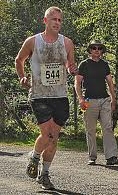 One certain way to get your players to run slower is to keep running them into the ground until all technique has been lost (pictured right).
One certain way to get your players to run slower is to keep running them into the ground until all technique has been lost (pictured right).
My focus is always on giving the players the tools to do the job. Coach them well, give the Run Faster programme.
You hopefully have read and followed our guides and built a good foundation, got the strength that you can apply, and become more agile. Now is the time to get faster.
The 2 key components of running faster
- Get a higher top speed
- Accelerate to that top speed
“But in my sport we never get to top speed as we only sprint over short distances” I used to think this way, thinking “what is the point of getting rugby props working on top speed?” (apart from amusement!)
The question you have to ask is “What am I accelerating towards?”
If your top speed is higher, then the percentage of that top speed that you are striving for at each stage of 5m, 10m, and 20m (common sprint distances in team sports) will also be higher.
So, if you can only get to about 45% of top speed at 10m (based on what Asafa Powell can do), then all things being equal, increasing your 60m speed will also help your acceleration.
Increasing your top speed.
Running is a co-ordination activity, it requires practise and refinement. I get the players to work on 7 different aspects of running (see here) and use a variety of drills designed to help them achieve this.
I focus on one thing at a time and vary the drills to challenge the learning and coordination of the players. Just like any other skill that you teach as a coach.
Get the players to practise running, focussing on that one aspect, then rest and repeat. Introduce the next drill, practice, and then use it when running. An example is shown in this video:
If you just run without technique focus, you will just get tired. If you just drill without applying them into the run, you just get better at drills.
Accelerate fast
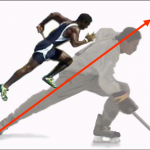 Acceleration is crucial in team sports. “More specifically, horizontal acceleration of body weight. The simplest and most accurate description from physics for explosiveness; quickness, agility and even speed”
Acceleration is crucial in team sports. “More specifically, horizontal acceleration of body weight. The simplest and most accurate description from physics for explosiveness; quickness, agility and even speed”
Jack Blatherwick GAIN 2011
The ability to control the body in a Straight Line Extension (SLX) is the difference between a fast person and a slower one. Strengthening drills that incorporate the whole body in that position are very useful.
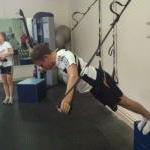 In the first 2-3 strides the Gluteal Muscles and Quadriceps are a key factor in providing force for the thrust. After that (5-25 metres) the coordination and SLX are more important.
In the first 2-3 strides the Gluteal Muscles and Quadriceps are a key factor in providing force for the thrust. After that (5-25 metres) the coordination and SLX are more important.
That is why your team must be doing lower body strength work, especially on single legs and in different planes.
I work on acceleration over 5-10m using a top-down and bottom-up approach.
Top-down is “Lean, fall and go” which can be done against a wall, with partner assist, harnesses and then “free fall”. This gets the players to practice their first step and feel comfortable with SLX.
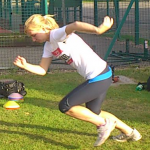 Bottom-up is from a bear crawl into a sprint. Bear crawl over 5m and then come up gradually into a sprint over 15m. This helps with reciprocal arm and leg action (coordination) and again on SLX.
Bottom-up is from a bear crawl into a sprint. Bear crawl over 5m and then come up gradually into a sprint over 15m. This helps with reciprocal arm and leg action (coordination) and again on SLX.
Tips for fitting in pre-season speed
“This all sounds well and good, but how do I fit it into my technical and tactical sessions?”
The traditional view of team sports coaches is diametrically opposed to that of speed coaches when it comes to work: rest ratios.
We can not have team sports players having 15 minutes rest between 300m intervals. This is the real world and time is precious. Similarly, we can not have “speed sessions” turning into shuttle runs with jog back recovery. That is not Speed.
I go for the more pragmatic approach of doing shorter speed sessions, more frequently. This way your players are able to cope mentally and physically with high-quality work, and you can then do your tactical \ technical coaching afterwards.
Active recovery of skill work such as passing and catching, or dribbling is acceptable, but remember only to do that walking or stationary.
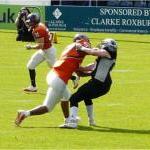 Every time you jog a drill, you have to finish it which requires braking: this is not resting. Metabolically your players will not appear tired, but mechanically they will have been loaded heavily.
Every time you jog a drill, you have to finish it which requires braking: this is not resting. Metabolically your players will not appear tired, but mechanically they will have been loaded heavily.
Stress is stress, and your body can only cope with so much.
Avoid the volume trap on speed.
I have found that good Coaches like me getting their players faster, more resilient and less likely to get injured. This has taken some change of thinking and heavy bartering on allocated times!
Perhaps, more importantly, players appreciate getting help on How to get faster, rather than being told to run faster.
(Download our Free “Run Faster Guide” here for 6 example sessions)
Or book in for an individual speed training package with James.

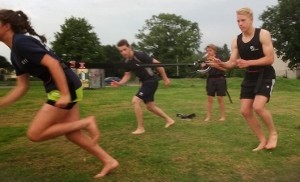
[…] 2 looked at nutrition, agility progressions and speed training techniques, plus pre activity assessments and […]
[…] month of our internship we have been learning about speed and the most effective ways to train for it writes Matt […]
[…] Speed is also included, because even at relatively constant speed, there is deceleration and acceleration with each stride. Horizontal acceleration of body weight is therefore one of the highest priorities in sports that feature speed, quickness, and agility. […]
[…] Bosch then went into more detail on the running mechanics themselves (regular readers and our athletes will have as seen this before). […]